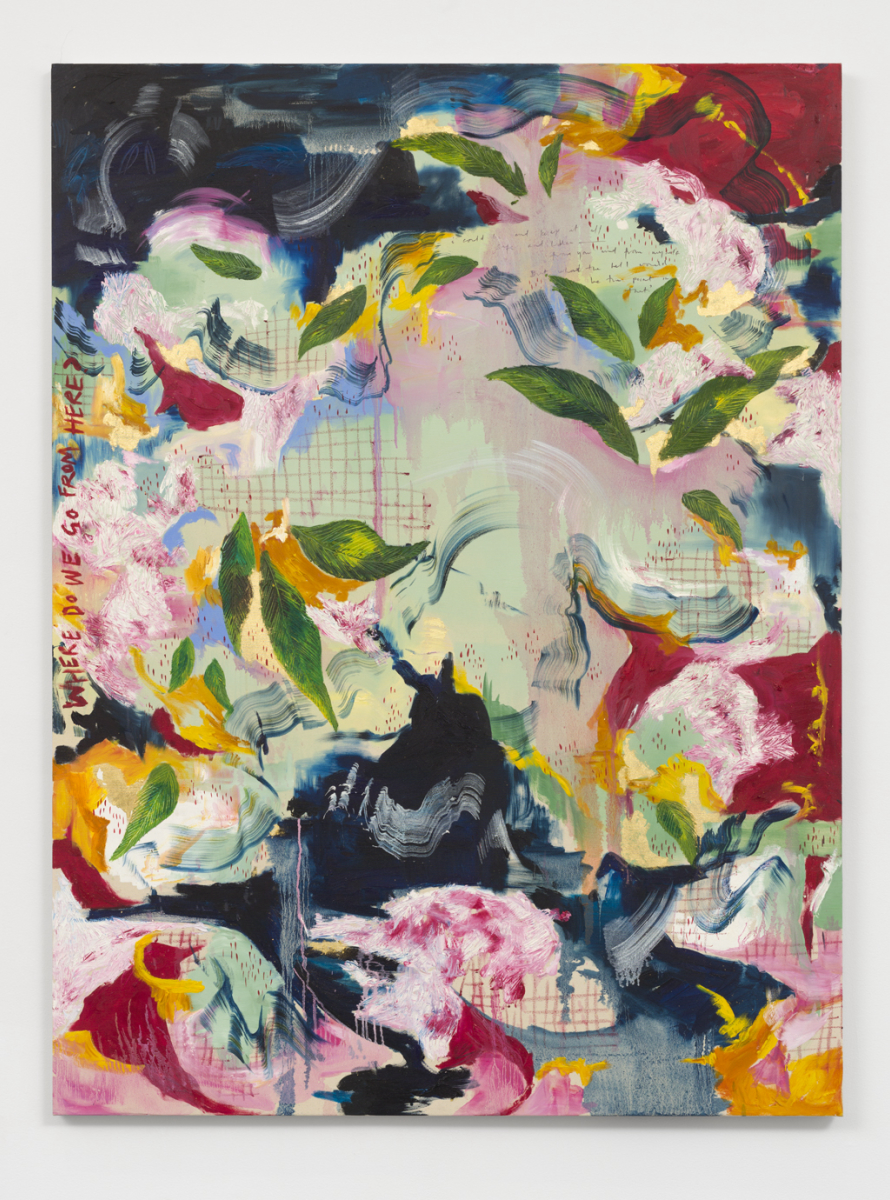Michaela Yearwood-Dan paints big, seductive paintings that reveal their secrets slowly. Your eye might settle on an intimate line of text tucked into a swirling composition of richly colored plants, or subtle flourishes of Swarovski crystals, acrylic nails or gold leaf applied to a painting’s surface. Or you might catch sight of cotton flowers, decorated with pearlescent beads and stitched into her canvases.
“I like to accessorize my work,” she says with a chuckle, over a recent Zoom call from her London studio. Yearwood-Dan, who is just 27 years old, has just wrapped the remote install of her first US solo show at Marianne Boesky in New York, on the heels of a busy couple of years—including joining the rosters of Marianne Boesky and London’s Tiwani Contemporary, collaborating with author Margaret Atwood on a cover for Harper’s Bazaar, and completing a mural commission for Facebook’s London offices.

The Boesky show featured sumptuous, semi-abstract works that document the artist’s emotional responses to the pandemic years, a period of anxiety, but also one in which she fell in love (her first “proper queer relationship”) and found relief in the new space for conversations about race that opened up following global Black Lives Matter protests. One of those works, A conduit for joy (2021), is a lavish diptych with the words “How does it get even better?” floating over gold leaf and a flurry of tropical color, windblown leaves and scatterings of crystals.
The artist’s impulse to adorn is as much about personal style as it is about the atmosphere she is trying to evoke in her paintings and the pleasure she takes in the process. Yearwood-Dan grew up in South London, which explains, she says, why she feels naked when she leaves her apartment without gold jewelry on—as well as something about the aesthetic choices in her paintings. She also enjoys the slow, delicate process of embellishing her canvases. And this streak of opulence has deeper, art-historical roots.

Yearwood-Dan went to Catholic schools as a kid and remembers gold-inflected religious imagery as some of the first she was exposed to. Her abstract arrangements of color and flora— often centered around a portal-like negative space in the middle of the composition—in some ways emulate “grand frescoes and the Sistine Chapel and the movements of big skies and unearthly visions,” she says, even as they express something much less grandiose and more personal. They represent, in her own words, the “diaristic, self-historicization of the emotions and feelings I’m going through.”
Lately, her compositions have taken on more movement—partly the result of having taught herself to make ceramics and turning her Leyton apartment into an impromptu clay studio during the lockdown in 2020. According to Yearwood-Dan, the process of painting onto spinning clay has loosened her handling of paint. “I think the work is also a lot more confident,” she says, as she has settled into a style and visual language that began to take shape some three years ago—but which is the manifestation of almost a decade of exploring her voice and identity.

Growing up in low-income housing, Yearwood-Dan was a self-professed theater kid and shared a love of the arts with her dad, but rarely went to museums save for occasional trips to the Victoria and Albert Museum, the Royal Academy and the Tate. She didn’t set foot in a commercial gallery until she was in her twenties. “I didn’t feel that I had the ability to access those spaces until I graduated,” she recalls.
An early encounter with Chris Ofili’s painting No Woman, No Cry (1998), a portrait of Doreen Lawrence—whose son Stephen was murdered in a racist hate crime in South London in 1993—helped Yearwood-Dan to envision a future as an artist. “Everyone talks about representation, but there are some moments of representation that do shake you to the core, and for me, it was discovering Chris Ofili at age 16 or 17,” she says. “Being a Black person growing up in South London, Stephen Lawrence and Damilola Taylor [who was killed, aged 10, in Peckham] were names I knew as if they were my cousins.” It was also the colors, the reference to Bob Marley and the distorted figure that made the painting feel familiarly African to her.
As an art student at Brighton University, where Yearwood-Dan was taught exclusively by white people, the feeling of being out of place in the art world persisted, and she felt she had to skew toward figurative painting in order to make work about racial disparities. Now, back in London and continuing to cultivate a more nuanced expression of her psychic state, Yearwood-Dan has numerous opportunities coming her way. But she cautions against the frenzy of interest in Black artists that has come in recent years. “The art world is very quick to emulate whatever is cool, fast-moving and liberal that is happening in the world,” she says. “If you want to work with me, let it be under the guise of an intellectual show that is not completely intrinsically linked to the fact that I am Black.” In 2020, she declined dozens of emails inviting her to participate in all-Black shows.
“The shift is great and deserved,” she adds, “but sometimes you have to think: Where is it going? And take the path of caution. Take the right opportunities and make sure the people you’re working with are authentic. Finally we’re able to have these conversations that in the community we’ve been having for a really long time,” she says. “We can’t get shut down.”










 in your life?
in your life?

